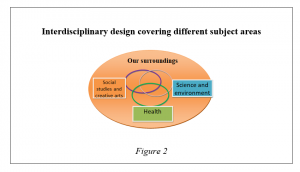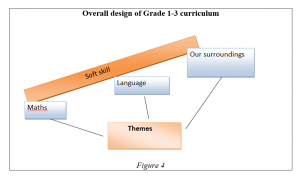
Scene setting
Schools, around the world, are gradually moving towards an integrated curriculum from a traditional subject-centered curriculum. Advocates of an integrated curriculum argue that it promotes holistic and meaningful learning that is linked to real life. In Nepal, an integrated curriculum for basic grades (1-3) has been developed and being piloted in grade 1 in selected schools in this academic session. Though the idea of an integrated curriculum is not new, its systematic practice in Nepal is new and therefore the stakeholders of education need to be clear about its concept. Integrated curriculum is a relative concept and curriculum integration is always a matter of degree. This article tries to provide a brief picture of an integrated curriculum for basic grades (1-3) in Nepal focusing mainly on the English subject area. It begins with brief background information about integrated curriculum. Next, it provides its theoretical concepts. After that there is a short synopsis of an English subject of an integrated curriculum. The article ends by providing a glimpse of the materials that have been developed based on integrated curriculum.
Key words: Integrated, multidisciplinary, interdisciplinary, themes, soft skills
Background
In Nepal an integrated curriculum for basic grades (1-3) has been developed and the curriculum of grade 1 is under piloting in 103 public schools in this academic year. The curriculum for grade 1 will be fully implemented in all the school of Nepal in the academic year 2077 (2020 AD) after the revision based on the feedback obtained from piloting. The integrated curriculum was developed as a refinement of traditional subject-centered curriculum. It is expected that the integrated curriculum counters the limitations of the subject-centered curriculum and makes learning holistic and meaningful. National Curriculum Framework (NCF, 2075) has made a provision for an integrated curriculum for basic grades (1-3). The NCF has made a provision for six major learning areas for grade 1-3 as shown in the table below:
Curriculum structure of basic education (grade 1-3)
| S. N. | Subject-related activities | Credit hour | Annual working hour |
| 1 | Activities related to literacy skills (Nepali) | 5 | 160 |
| 2 | Activities related to literacy skills (English) | 4 | 128 |
| 3 | Activities related to numeracy skills | 4 | 128 |
| 4 | Activities related to science, health and physical education | 4 | 128 |
| 5 | Activities related to social studies, character development and creative arts | 4 | 128 |
| 6 | Activities related to mother tongue/local contents | 5 | 160 |
| Total | 26 | 832 |
Source: Basic level (grade 1-3) curriculum, 2075, p. 5
Concept of an integrated curriculum
In a general sense, integrated curriculum is defined as a curriculum that interlinks learning of more than one domain or learning area. It can also be defined as a curriculum that promotes holistic learning by helping the children to make connections. This type of curriculum makes learning relevant to learner’s life and develops problem solving skills in the students by providing them “minds-on” and “hands-on” learning processes. Humphreys (1981 as cited in Lake 1994, pp. 1-2 ) states, “An integrated study is one in which children broadly explore knowledge in various subjects related to certain aspects of their environment”. The term interdisciplinary is often used to refer to an integrated curriculum. Jacobs (1989 as cited in Lake 1994 pp. 1-2) defines interdisciplinary as “a knowledge view and curricular approach that consciously applies methodology and language from more than one discipline to examine a central theme, issue, problem, topic, or experience”. These definitions support the view that integrated curriculum is an educational approach that prepares children for lifelong learning.
The rational for an integrated curriculum
It is commonly accepted that we need integrated curriculum:
- To promote collaborative learning.
- To reflect the real world in the learning process.
- To connect school with society.
- To motivate the learners for learning.
- To check in the fragmentation of learning and to make learning more integrated and holistic.
- To give learners an opportunity to learn in their own place.
- To make learning relevant for life by integrating soft skills in the learning process.
Approaches to curriculum integration
There are various approaches to curriculum integration. Susan Drake (2018) discusses the three framework for planning the integrated curriculum.
Multidisciplinary: In this model, the same topic or theme is addressed by each of the separate disciplines. It retains the integrity of each discipline. Multidisciplinary approaches focus primarily on the disciplines. Teachers who use this approach organize standards from the disciplines around a theme. The standards of the disciplines organised around a theme is the organising center in this model.
Interdisciplinary: In this model, specific skills, processes or ideas which are common to all disciplines are identified and they are addressed through the disciplines. Learning to learn is the organising factor in this model. In this model, teachers organize the curriculum around common learning across disciplines. They chunk together the common learning embedded in the disciplines to emphasize interdisciplinary skills and concepts.
Trans-disciplinary: In this model, the focus of curriculum planning is ‘life-centered approach’. Knowledge is examined as it exists in the real world. The content to be learned is determined by the theme and the expressed interests and need of the students, rather than predetermined by some curriculum framework or set of curriculum objectives. In this model, teachers organize curriculum around student questions and concerns. Real-life context and student questions are the organising center of this model.
Continuum of curriculum integration
Integrated curriculum is not an absolute concept rather it is a relative concept and a matter of degree. Scholars have proposed various designs of integrated curriculum ranging from loosely integrated to highly integrated. The following figure represents the continuum of integrated curriculum.

As shown in the figure above, disciplinary curriculum is loosely integrated in nature. The existing school curriculum of Nepal is an example of it. At the opposite end of the continuum, there is a trans-disciplinary curriculum which is deeply integrated in nature. This sort of curriculum is rarely practised in the world. Only a few European schools have practised this sort of curriculum. In this type of curriculum, there exist no subjects. Students are involved in projects and problem-solving tasks.
Designed curriculum as integrated curriculum in Nepal
The present integrated curriculum for basic grades (1-3) in Nepal is based on multidisciplinary and interdisciplinary design. It is important to note here that there were six different subjects in the Primary Education Curriculum 2063 as mentioned below:
- Nepali
- English
- Maths
- Social studies and creative arts
- Science, health and physical education and
- Local subject/mother tongue
In the new integrated curriculum (2075) there are only three learning domains: language, maths and our surroundings. The language domain includes three languages Nepali, English and mother tongue. Maths remains as a separate discipline. The learning domain ‘our surroundings’ consists of the following subjects of the old curriculum:
- Social studies and creative arts,
- Science, health and physical education
Thus, the current interdisciplinary design of the integrated curriculum can be shown below in the figure.

It is clear from the above figure that the learning domain ‘Our surroundings’ incorporates three subjects, i.e. ‘Social studies and creative arts, Science and environment and Health.
As already mentioned the present integrated curriculum for basic grades consists of three main disciplines language, maths and our surroundings. It means that these three learning areas remain as separate disciplines and thus form a multidisciplinary design. This can be presented in the following figure.

The overall design of the Grade 1-3 curriculum
The overall design of the grade 1-3 curriculum can be best presented with the help of the following figure.

It is clear from the above figure that the present integrated curriculum for grades 1-3 consists of three disciplines maths, language, and our surroundings. These learning areas have been linked by the common themes and various soft skills have been incorporated across the disciplines.
Themes as the linking forces in the integrated curriculum
It should be noted that the present integrated curriculum for grades 1-3 is a theme-based curriculum developed following multidisciplinary and interdisciplinary design. Various themes such as Me and My Family, My School, Our Culture, Birds and Animals and Fruits and Vegetables have been proposed in order to establish a link among the disciplines. There are two types of themes in the curriculum: common themes and subject-specific themes. Some themes are common to all the four subject areas, i.e. Nepali, English, Maths and Our Surroundings, and rest of others are specific to the subject.
Soft skills that have been integrated into the curriculum
The integration of various soft skills is one of the key features of the present integrated curriculum. The major soft skills that have been integrated across the subject areas have been mentioned below.
- Thinking skills
- Intrapersonal skills
- Interpersonal skills
- Information Communication and Multi-literacy skills
Key features of the English domain of an integrated curriculum
The English subject area of the integrated curriculum is based on the Communicative Approach to Language Teaching (CLT) as a theory of language teaching and learning. So far as curriculum design is concerned, it is based on a multi-strand model because it incorporates various models and approaches to curriculum development. It consists of language skills, language functions and also themes. Thus, its aim is to develop comprehensive communicative competence in the learners. There are six level-wise competencies and various learning outcomes in the curriculum. One new learning area has been added to conventional four language skills, i.e. viewing and presenting. It is integrated in nature. It is competency-based and various soft-skills have been integrated in it. There are altogether 11 themes: Six multidisciplinary (common) themes and five subject-specific themes. Themes are the tools to integrate learning. It demands team planning and teaching to integrate learning across disciplines.
Materials developed apart from the curriculum
In addition to the curriculum, two types of learning materials have been developed: curriculum implementation guideline and student’s workbook.
Curriculum implementation guideline: The curriculum implementation guide-line is designed to assist the teachers in planning their units and lessons. It is basically a pedagogical guideline for the teachers. Curriculum basically articulates why to teach and what to teach. It says a broader pedagogical approach in a general sense but cannot provide a detail pedagogical support to the teacher. In order to address this aspect, a curriculum implementation guideline has been developed. It consists of a wide variety of suggested activities for the teachers.
Students’ workbook: Student’s workbook is the key learning material developed for the students. It is different from the traditional textbook. Traditional textbook basically focused on the contents and it did not consist of sufficient activities for students to practice language skills. On the contrary, the present workbook consists of several activities for the students. It is, in fact, a blended form of textbook and workbook because it includes both content and activities for self and guided practice for the students.
Conclusion
The initial feedback obtained from the teachers and the students shows that an integrated curriculum is effective in encouraging learners for active and engaged learning. It encourages collaboration and communication among both the teachers and the students. Since it demands team planning and grade teaching, there is an increased level of teacher preparation before teaching. When we implement the curriculum throughout the country teacher preparation becomes an important and challenging task. In any curricular innovation teacher resistance is a possible risk, and there is no guarantee that we do not face this risk in this case. Until and unless the teacher, a real hero in the classroom, is clear, convinced and enthusiastic to implement a new curriculum and curricular materials, no matter how effective the curriculum is, it does not work. Therefore, careful and effective teacher preparation is necessary before we launch it in a large scale. In the same way, the curriculum and materials based on its need to be timely revised and made available incorporating the feedbacks obtained from its piloting.
References
Curriculum Development Center (2006). Primary education curriculum (grade 1-3). Sanothimi Bhaktapur; Curriculum Development Center.
Curriculum Development Center (2008). Primary education curriculum (grade 4-5). Sanothimi Bhaktapur; Curriculum Development Center.
Curriculum Development Center (2019). Basic level (grade 1-3) curriculum. Sanothimi, Bhaktapur; Curriculum Development Center.
Curriculum Development Center (2019). Curriculum implementation guideline, English. Sanothimi, Bhaktapur. Curriculum Development Center.
Drake, S.M. & Reid L. J. (2018). Integrated Curriculum as an Effective Way to Teach 21st Century Capabilities. Asia Pacific Journal of Educational Research. Vol. 1(1) 31-50.
Lake, K. (1994). Integrated Curriculum. Office of Educational Research and Improvement (OERI), U.S. Department of Education.
The author
Ramesh Prasad Ghimire is currently an Officer at Education Training Center, Dhulikhel. He was the coordinator of an English subject area of an integrated curriculum while he was working in the Curriculum Development Center. His areas of interest include English language teaching (ELT) material development, teacher training and instructional leadership.
Continue reading Place of English in the integrated curriculum for early grades (1-3) in Nepal
